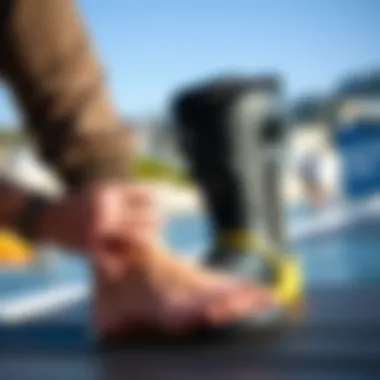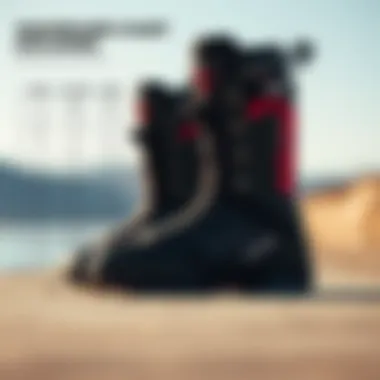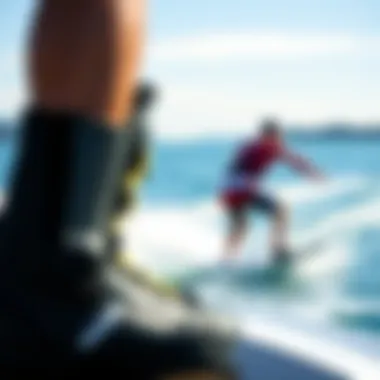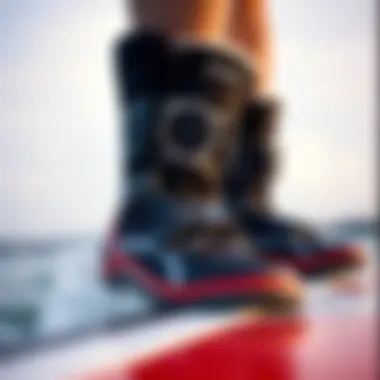Understanding Wakeboard Boot Sizes: A Guide


Intro
Selecting the correct wakeboard boot size is not just a matter of putting your foot in a boot and hoping for the best. It’s about maximizing your comfort and performance on the water, which can significantly affect your overall wakeboarding experience. In this guide, we will delve into essential factors such as accurate foot measurement, size charts, and the nuances that influence how boots fit. Whether you're a novice looking to take your first ride or a seasoned pro aiming to fine-tune your equipment, understanding how to select the right boot size can make all the difference.
Expert Insights
Latest Trends in Watersports
The world of watersports is evolving rapidly, not only in terms of equipment but also in terms of understanding how gear interacts with the rider. Manufacturers have recently focused on crafting boots that cater not just to various foot shapes but also to different riding styles. For instance, some boots now feature adjustable cuffs that allow for a customized fit, accommodating both wide and narrow feet. The integration of lightweight materials has also become a game changer, helping riders achieve better air control when performing tricks.
Staying updated with these trends can give wakeboarders an edge. Knowledge of the latest releases helps you make informed decisions when purchasing gear, particularly boots that deeply affect your response on the board.
Safety Protocols and Best Practices
When it comes to water sports, safety should always be number one on your list. A well-fitted boot plays a crucial role in keeping wakeboarders secure while being towed at high speeds. Here are some safety protocols to consider:
- Choose the right size: A boot that is too large can slip off, while one that is too tight could cut circulation.
- Inspect your gear regularly: Check for signs of wear and tear. Damaged boots can lead to accidents.
- Wear a life jacket: Always wear a Coast Guard-approved life vest to ensure safety in the water.
"Early prevention is better than a cure, especially in wakeboarding."
Equipment Recommendations
Must-Have Gear for Beginners
If you are stepping into the world of wakeboarding for the first time, having the right gear is essential. For new riders, here are a few suggestions on must-have items:
- Beginner wakeboard boots: Look for models with a soft flex that allows more forgiving landings.
- Board with a wider profile: This stability aids in maintaining balance during your first rides.
- Life vest: Ensure that it's well-fitted and offers adequate buoyancy.
A proper setup can make learning to wakeboard less daunting and more enjoyable, letting you focus on the fun of the sport instead of struggling with equipment.
Advanced Equipment for Pros
For those who have mastered the basics and are looking to push their limits, advanced gear becomes crucial:
- High-performance wakeboard boots: Seek out models with a stiffer flex that provide excellent response.
- Carbon fiber boards: These offer lightweight construction for higher jumps and tricks.
- Bindings with customizable settings: Having the ability to adjust your bindings helps in efficiently transferring edge control.
Opting for specialized equipment that matches your skills is paramount. Researching various brands and models will ensure you stay comfortably attuned to the water, allowing your skills to shine.
Prologue to Wakeboard Boot Sizes
Selecting the proper wakeboard boot size might seem like a trivial detail at first glance, yet it has far-reaching implications on performance and comfort for both novice and experienced riders alike. Finding the correct size ensures not only a better fit but also enhances your overall experience on the water. An ill-fitting boot can translate into discomfort, reduced control over the board, and potential safety hazards.
Importance of the Right Boot Size
Having the right boot size is crucial for various reasons:
- Control and Precision: When your boots fit well, you gain enhanced control over your movements. This is imperative during jumps or tricks, where precision can make or break your performance.
- Comfort and Endurance: A correctly sized boot allows for a comfortable ride, reducing the risk of blisters and fatigue. You want to enjoy your time on the water, not spend it wincing in pain.
- Safety First: Loose or overly tight boots might hinder your ability to respond to unexpected shifts in balance or pressure on the board, increasing the risk of injuries.
- Tailored Experience: The right fit can enhance your riding style. Whether you're a recreational rider or an avid competitor, comfort in your gear will undoubtedly impact your confidence and performance.
As you ponder your options, remember that this choice is not just about finding something that looks good or fits the budget. When it comes to boots, every little detail matters in achieving that perfect ride.
"Fit, comfort, and performance. These three pillars can elevate your wakeboarding game to new heights."
In short, understanding the importance of wakeboard boot sizes is the first step towards mastering the art of wakeboarding. You’re not just picking shoes; you’re setting yourself up for a more enjoyable and successful time on the water.
Understanding the Basics of Wakeboard Boots
In the exhilarating world of wakeboarding, the significance of a well-fitted boot cannot be overstated. To ride the waves smoothly, understanding the essentials of wakeboard boots is crucial. This understanding not only aids in performance but also enhances overall comfort while riding. Therefore, getting familiar with the different styles, materials, and key features of wakeboard boots forms the foundation for your experience on the water.
Types of Wakeboard Boots
Different types of wakeboard boots cater to various riding styles and preferences. Selecting the right type can truly transform the way you ride.
Open Toe Boots


Open toe boots are designed with a more relaxed, open design that allows for some adjustment in size. This can be a great advantage if you’re riding with friends having foot sizes that slightly differ. The key characteristic of open toe boots is their breathability. This feature provides excellent ventilation, making them suitable for warm weather conditions. Additionally, they often offer a lighter weight for the rider, enhancing agility on the board.
However, an important consideration is that if you have smaller feet, you might find your foot shifting slightly, which could affect stability.
- Advantages: Good ventilation, versatile fit, lightweight
- Disadvantages: Less stability for smaller foot sizes
Closed Toe Boots
Closed toe boots provide a snugger fit, fully enclosing the toes. This creates a more secure bonding between the boot and rider’s foot, offering better control during sharp turns or jumps. The key characteristic here is the enhanced responsiveness they provide, giving riders greater confidence on the water. For those aiming for high performance, closed toe boots are often the go-to choice.
On the downside, they may run a bit warmer, especially on hot days, which could lead to discomfort over long periods of use.
- Advantages: More responsive control, secure fit
- Disadvantages: Less ventilation, possibly uncomfortable in heat
Key Features of Wakeboard Boots
Beyond the type of boot, several key features can greatly impact performance and comfort.
Lacing Systems
Lacing systems are critical in ensuring a snug fit for your wakeboard boots. The specific aspect to focus on is the ease of use. Many modern boots offer quick lace systems or dual-zone lacing, allowing for fast adjustments while on the go. This feature can be particularly beneficial during a long day on the water, where comfort is paramount. A well-designed lacing system contributes to the boot’s overall fit and can help reduce foot fatigue.
Furthermore, while it’s easy to overlook, the durability of the lace material itself can influence the boot’s lifespan.
- Advantages: Quick adjustments, improved fit, reduces fatigue
- Disadvantages: Complex systems may require more maintenance
Chassis Design
Chassis design plays a foundational role in how the boot holds up under pressure when riding. The key characteristic of chassis design lies in its capability to offer support without compromising flexibility. A well-designed chassis aligns with the shape of your foot, ensuring a comfortable ride while allowing movement essential for tricks and jumps. The right chassis can drastically improve a rider's control over the board.
However, a stiffer chassis may limit movement slightly, which could deter riders looking for maximum agility.
- Advantages: Improved support and control
- Disadvantages: Possible restriction in flexibility
Cushioning Technology
Cushioning technology is another vital feature to consider, adding layers of softness and shock absorption. The specific aspect of this technology affects comfort, especially during high-impact activities or landings. A boot with advanced cushioning will help in reducing the strain on the ankles and feet, making long sessions more enjoyable. Many brands incorporate memory foam or gel-infused materials creating a custom fit for the rider.
Nevertheless, it’s essential to balance cushioning with responsiveness; too much cushioning can lead to a lack of connection to the board.
- Advantages: Enhanced comfort and shock absorption
- Disadvantages: Potential loss of board feel
In summary, understanding the basics of wakeboard boots, including their types and key features, is instrumental in enhancing your overall riding experience.
As you explore the wakeboarding landscape, remember that the right combination of these elements can elevate your performance significantly.
Wakeboard Boot Size Chart Explained
Understanding the appropriate wakeboard boot size is null and void without the context of a well-defined size chart. The boot size chart serves as a crucial tool for anyone venturing into the world of wakeboarding. ASize charts help individuals identify their perfect fit by correlating foot measurements with the right boot size. This is not simply a matter of comfort; the correct size can dramatically affect performance on the water. A snug fit ensures that the rider can transfer their movements to the board effectively, resulting in more controlled and optimal riding.
When interpreting a boot size chart, one must consider a few vital aspects, as the fit of a wakeboard boot can be quite subjective. Factors such as brand differences and technology implemented can lead to variations in sizing even among small incremental size differences. Hence, what fits one brand might feel off in another.
Standard Boot Size Measurements
The standard boot size measurements typically include both foot length and width, and it is important to find a precise match. Most manufacturers produce their sizes based on US, UK, or European sizing systems. Here’s a breakdown of how these bulk measurements generally convert with some minor peculiarities:
- US Sizes: These are usually the most common in the States and vary slightly from brands. A 9 in one brand might not fit the same as a 9 from another.
- UK Sizes: Generally a half size difference from US sizes. If you're a US 9, expect to be around an 8.5 in UK sizing.
- EU Sizes: These have their own metric measures, often requiring extra conversions.
To avoid guesswork, it's best to measure your foot’s length in centimeters and check it against the specific brand’s size chart. Each manufacturer typically lists a detail table to guide purchasing.
"A good fit is not just nice to have – it’s a necessity for reaching peak performance on the water."
Conversion Between Men's and Women's Sizes


Navigating shoe sizes between men's and women's options can be like opening a can of worms—confusing at best. Generally, women’s sizes are about 1.5 to 2 sizes smaller than men’s sizes. For instance, if a woman wears a size 8, she would more likely fit a size 6.5 or 6 in men's sizing. However, this is where it can get tricky; specific models often differ in cut and design, which can affect fit altogether.
When making conversions, it's wise to always refer to each brand's specific size chart and conversion guide. One might be puzzled at how one size fits like a glove from one brand but then feels too sloppy from another; this intricacy underlines the necessity of close inspection when selecting the right boots.
Helpful tips for conversion:
- If possible, try on the boots to see how they truly fit your specific foot shape.
- Examine user reviews that often speak to the fit issues related to gender differences.
How to Measure Your Foot for Wakeboard Boots
Measuring your foot accurately is crucial when selecting wakeboard boots, as the right fit can considerably impact your performance and comfort on the water. Poorly fitted boots can lead to discomfort, lack of control, and even injury, while the perfect pair enhances your ability to maneuver with precision. This section breaks down how to make sure your measurements are spot-on, ensuring that you can enjoy your time on the wake without any hiccups.
Gathering the Necessary Tools
To get started, you need a few basic items to help you measure your foot correctly. The process is straightforward, but having the right tools at hand can save you from potential mishaps later. Here’s what you’ll need:
- A ruler or tape measure: You’ll want a flexible tape measure, like the kind used in sewing or crafting, for accurate measurements around curves. However, a rigid ruler can work if you’re careful.
- A piece of paper: Grab some standard printer paper to trace your foot on.
- A writing instrument: A pencil or pen is essential for marking your measurements.
- A flat surface: Ensure you have a hard, flat surface to work on, as it will yield better results when measuring.
- Socks (optional): If you plan to wear socks with your boots, wear a pair that resembles what you would typically wear while wakeboarding. This will give more accurate results when measuring.
Step-by-Step Measurement Process
Once you have your tools ready, you can proceed with the measurement. Follow these steps to get an accurate size for your wakeboard boots:
- Prepare Your Foot: Sit down in a relaxed position, placing your foot flat on the paper. Ensure that your weight is evenly distributed on the foot you’re measuring.
- Trace Your Foot: Using your writing instrument, carefully trace the outline of your foot. Keep the pen perpendicular to the paper and make sure to capture the contour of your entire foot, including the arch and toes.
- Identify Length and Width: After tracing, measure the longest length from the heel to the tip of your big toe. Then, measure the widest part of your foot. Knowing both measurements is key to finding a good fit.
- Record the Measurements: Write down your recorded length and width. It’s often helpful to measure both feet, as they can be slightly different in size.
- Consult a Size Chart: With your measurements in hand, refer to the manufacturer’s size chart for the specific boot brand you’re considering. Each brand may have a slightly different sizing guide, so be sure you’re looking at the right one.
Remember, when it comes to sizing, being one or two centimeters off can alter the fit and comfort significantly. Therefore, take your time and ensure you're not skipping any steps.
- Consider Comfort: Once you find a size that corresponds to your measurements, remember to think about how it feels. Ideally, you want a snug fit without excessive pressure points. So, this can be a good spot to consider that slightly larger size if you're in between sizes.
By following this measurement process, you’ll set yourself up for success on the water. Understanding how to accurately measure your foot for wakeboard boots can influence your performance, so don't overlook these steps. Happy measuring!
Factors Influencing Boot Fit
Selecting the correct size for wakeboard boots is akin to finding the perfect pair of shoes for a special occasion; there are several factors to consider that go beyond mere measurements. Understanding the nuances that affect boot fit can significantly enhance your riding abilities, prolong your comfort, and minimize any discomfort that could arise from a poorly fitting boot. A precise fit enables riders to maintain better control and improve their overall performance on the water. Thus, addressing factors that influence boot fit isn't merely a footnote in the wakeboarding experience but rather a foundational aspect that every rider should take seriously.
Foot Shape and Width
The shape and width of an individual's foot play a pivotal role in determining which wakeboard boots will offer the best fit. Feet are not uniform; they come in various shapes, from narrow to wide, and the arch can range from low to high. It's essential to consider these variables when selecting boots. For instance, someone with a wider foot may find that some brands' standard sizes pinch at the sides, leading to a less-than-stellar experience on the water.
Important considerations include:
- Arch Type: Riders with high arches might need more support, affecting the choice of boot.
- Width: Brands often classify boots as narrow, standard, or wide. Know what suits your foot's width to avoid squeezing or slipping.
- Length: A foot that is slightly longer or shorter than average might require a different sizing than expected.
It is advisable to try on multiple brands and styles; many manufacturers present varying fits even in the same size range. Finding the right boot may require some trial and error, but this investment of time is worth its weight in gold.
Riding Style Considerations
Your personal riding style serves as another significant factor influencing the fit of your wakeboard boots. Whether you're an aggressive rider, a casual cruise type, or somewhere in between can dictate what features and fits you require in a boot.
- Aggressive Riders: If you like to push limits and perform complex tricks, you might benefit from a tighter fit, offering more control. A snug boot can help in transmitting movements and intentions more efficiently.
- Casual Riders: Conversely, if you just enjoy an easy day on the water, you may prefer a boot that feels slightly looser, emphasizing comfort more than precision.
- Freestyle or Cable: Those into freestyle riding or using cable parks may opt for different lacing systems or boot designs that enhance foot management.
Riding tendencies also dictate how flexible or stiff a boot should be. Generally, stiffer boots provide better support for aggressive movements, while softer boots might offer more comfort for leisurely rides.
"The perfect fit and type of wakeboard boot can make the difference between riding the waves and sinking in the shallows."
The Role of Comfort in Performance
Comfort in wakeboarding is more than just a luxury; it's a necessity that directly influences a rider's performance on the water. Choosing the right wakeboard boot size impacts everything from control to endurance during a session. When your feet are snug and well-supported in the boots, it translates not just into better stability, but it also enhances your overall experience.
Impact of Poor Fit on Riding
A poor fit can turn a thrilling ride into a frustrating ordeal. If your boots are too tight, it can cause excruciating pain, potentially leading to numbness or even blisters. No one wants to be cutting their session short due to discomfort. On the flip side, boots that are too loose can result in lack of control. Your feet might slide around too much, throwing off your balance just when you need precision the most.
Several riders underestimate how much a proper fit contributes to their riding style. For instance, when performing tricks or making sharp cuts, having a secure connection between your foot and the board is essential. A tight or ill-fitting boot can lead to an increased risk of falls and injuries. Right footwear may feel like a small detail, but it can make a world of difference on the water.


Long-Term Comfort Considerations
When it comes to wakeboarding, comfort shouldn't just be about that initial fit, it’s also about long-term performance. As you ride over time, your feet can change; conditions like swelling can occur, especially during long sessions. Therefore, it's wise to think about the adaptability of your boots to accommodate these changes. This is where cushioning technology and adjustable lacing systems starkly come into play.
Investing in boots with high-quality padding and advanced designs can help distribute pressure evenly across your feet, minimizing fatigue. Moreover, keep in mind that your riding frequency can affect your comfort level. Riders who hit the water often should consider boots that provide additional support, as well as moisture-wicking material to keep feet dry.
Regularly checking how your boots fit as seasons change can also save you from future discomfort. As foot size can subtly shift over time, ensuring the right fit year-round can prolong your riding enjoyment. Overall, silhouettes that enhance comfort throughout your performance remain the unsung heroes of wakeboarding.
Common Misconceptions About Boot Sizing
When it comes to wakeboarding, selecting the right boots involves more than just picking a size off the shelf. The topic of boot sizing is often clouded by myths and misconceptions that can lead to discomfort and suboptimal performance on the water. It's crucial to dispel these myths to ensure that enthusiasts—whether athletes, coaches, or casual riders—make informed decisions.
Making assumptions about boot sizes based solely on general rules can lead to a poor experience. Understanding the nuances and realities behind these misconceptions can prevent aspiring wakeboarders from making costly mistakes. A well-fitted boot enhances performance and maximizes comfort, which is particularly vital during long stretches on the water.
Myths vs. Reality
Diving into the myths surrounding wakeboard boot sizing reveals a tangled web of misunderstandings that can confuse even the most seasoned riders.
- Myth 1: All Brands Follow the Same Sizing
Reality: Boot sizes can vary significantly across different brands. Just like shoes, what might fit you perfectly in one brand could feel tight or loose in another. Always refer to each manufacturer’s specific size chart and try the boots whenever possible. - Myth 2: Size Is All That Matters
Reality: While size is important, the fit of the boot is equally crucial. The shape of your foot, its width, and even your riding style all play a role in determining how a boot will feel in action. Open-toe and closed-toe designs fit differently, and the best choice often depends on personal preference. - Myth 3: A Tight Fit Equals Better Performance
Reality: There's a common belief that tightly fitting boots provide better control. However, an overly tight fit can lead to unwanted pressure points and discomfort, hampering your performance instead of enhancing it. Aim for a snug fit that allows for some freedom and doesn’t cut off circulation. - Myth 4: You Can Use Size Conversion Charts Without Verification
Reality: Size conversion charts are merely guidelines. They don’t account for individual foot shapes and other variations. If you transition from men’s to women’s sizes or from one country’s sizing system to another's, it’s critical to try the boots on before making a purchase. - Myth 5: New Boots Will Stretch to Fit
Reality: Unlike some materials, wakeboard boots often don’t stretch much over time. Therefore, it's wise to get a good fit from the start rather than relying on them to break in.
Understanding these misconceptions can lead to smarter purchasing decisions. When you recognize that choosing the right wakeboard boots is more nuanced than simply matching numbers, you position yourself for an enjoyable wakeboarding experience.
For further reading on sizing, consider checking out Reddit discussions or visiting sites like Britannica, which can offer broader insights into gear selection for various sports.
Best Practices for Choosing Wakeboard Boots
Selecting the right wakeboard boots is vital to ensuring an enjoyable and productive time on the water. Understanding best practices not only enhances your performance but also safeguards foot health, making every ride smoother. Wading through the options available can get overwhelming, but a few straightforward strategies can help streamline the process.
One key approach is to try on different boots. Each model tends to have its own fit and feel, influenced by factors like materials, design, and intended use. Personal preference plays a critical role here; what feels snug and supportive for one rider may seem too tight or too loose for another. Moreover, consider the boots’ features such as flex rating, which significantly affects how they perform in water. This flexibility often varies according to riding style - freestyle riders typically prefer softer boots for better maneuverability, whereas boat riders might opt for stiffer ones to enhance control.
Trying Before You Buy
Boot fittings shouldn’t be rushed. Trying on boots in person gives you the opportunity to assess factors like:
- Comfort: When you slide your foot in, the boot should feel snug but not painfully tight. If it pinches or feels overly constrained, move up a size.
- Support: Check how ankles are cradled. You want a balance that permits good movement while ensuring the foot and ankle have ample support.
- Lacing systems: Pay attention to the style—traditional laces versus Boa systems. Both have their pros and cons, but ultimately, it boils down to personal taste.
It’s best to wear the kind of socks you would typically use while wakeboarding, since that can influence how the boot fits. A good trick is to do a little movement in the boots once you’ve tried them on. Walk around the store, flex your feet, and simulate some riding motions. If the boots start to feel uncomfortable during these adjustments, they're probably not the right fit for you.
Consulting with Professionals
Don’t underestimate the value of expert advice. Consulting with professionals can provide insights that you might not arrive at independently. Local shops often have trained staff who are familiar with various boot brands and their sizing variations. Speak with them about your riding style and preferences. They can recommend models based on their extensive knowledge base.
Online forums and communities can also be of assistance. Websites like Reddit have dedicated threads discussing gear experiences where other riders share firsthand insights. Engaging with social media groups can lead you to unearth both positive and negative aspects of specific boots. Connecting with other athletes allows you to grasp how different options align with diverse riding styles.
Always consider your long-term needs while consulting with experts. Ask questions about boot longevity, and performance over time.
"Asking the right questions often yields the right answers in the world of sports gear."
A combination of practical trials and professional guidance will ensure you find your ideal wakeboard boots, making your time on the water more enjoyable and freeing.
Ending: Navigating Your Boot Purchase
Choosing the right wakeboard boots is a pivotal aspect of elevating your experience on the water. This article has covered a multitude of crucial factors—from sizing measurements to understanding foot shape and boot technology—to ensure you make an informed decision. Each piece of information discussed serves a purpose: to simplify your purchase and enhance your riding experience. When you navigate through the process of selecting boots, it can sometimes feel overwhelming, but being well-equipped with knowledge makes all the difference.
Summary of Key Points
In this guide, we've highlighted essential points that summarize the process and importance of selecting the right wakeboard boots:
- Measurement Matters: Knowing how to measure your foot correctly is foundational to finding the perfect fit.
- Understanding Boot Types: Different styles, such as open toe versus closed toe, cater to varying riding preferences and conditions.
- Size Conversions: Awareness of size differences between men’s and women’s boots is essential to avoid confusion when making a selection.
- Fit Influencers: Consideration of personal foot shape, width, and riding style helps in identifying the ideal pair.
- Comfort Equals Performance: A well-fitting boot not only ensures your comfort but also directly impacts your ability to perform on the water.
Remember, a single misstep in boot size or fit can lead to discomfort and reduced effectiveness out there on the wake.
Encouragement for Selective Shopping
As you embark on the shopping journey, be intentional and selective. Do not rush the process; take the time to try different boots before making a commitment. Here are a few tips to keep in mind:
- Visit Local Shops: Trying boots in person allows you to feel the fit and support firsthand. Retailers often have experienced staff who can assist you in finding the right size.
- Consult Experts: Engaging with coaches or seasoned wakeboarders can provide valuable insights into what boot characteristics may pair well with your riding style.
- Read Reviews: Online communities, such as forums on Reddit or dedicated wakeboarding sites like WakeWorld, can offer real-world feedback on particular brands and styles.
- Consider Return Policies: When buying online, ensure that the retailer has a reasonable return policy; after all, it’s better to try them in action!
- Invest Wisely: Quality boots can be costly, but they’re a long-term investment in your sport. Focus on durability, comfort, and fit rather than purely on aesthetics.
Purchasing wakeboard boots should be a thoughtful process. By harnessing the insights from this guide, you’ll be more prepared to make a choice that aligns perfectly with your needs and preferences.







